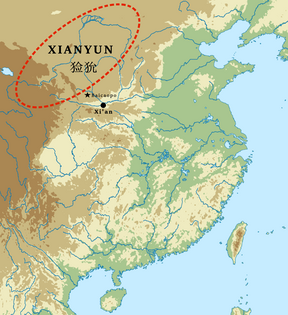This article should specify the language of its non-English content, using {{lang}}, {{transliteration}} for transliterated languages, and {{IPA}} for phonetic transcriptions, with an appropriate ISO 639 code. Wikipedia's multilingual support templates may also be used. (December 2021) |
Xianyun
猃狁
猃狁
Anthropomorphic axe, bronze, excavated in the tomb of Heibo (潶伯), a military noble in charge of protecting the northern frontier, at Baicaopo, Lingtai County, Western Zhou period (1045–771 BCE). Gansu Museum. This is considered as a possible Chinese depiction of a Xianyun or Guifang.[1]
"Europoid faces" are also known from Western Zhou scabbard ornaments of the 10th century BCE,[2] suggesting that people of "probably West Asian—origins may have arrived at China's northwestern borders" around that time.[3]
"Europoid faces" are also known from Western Zhou scabbard ornaments of the 10th century BCE,[2] suggesting that people of "probably West Asian—origins may have arrived at China's northwestern borders" around that time.[3]
General location of the Xianyun, who "lived in an area that stretched from the Hetao (bend of the Yellow River) to the upper Yellow River Valley", with the Chinese capital Xi'an and Western Zhou frontier outpost of Baicaopo ( ) next to this area.[4]
) next to this area.[4]

The Xianyun (simplified Chinese: 猃狁; traditional Chinese: 獫狁, 玁狁; pinyin: Xiǎnyǔn; Wade–Giles: Hsien-yün; Old Chinese: (ZS) *g.ramʔ-lunʔ; (Schuessler) *hɨamᴮ-juinᴮ < *hŋamʔ-junʔ[6]) was an ancient nomadic tribe that invaded the Zhou dynasty.[7] This Chinese exonym is written with xian 獫 or 玁 "long-snouted dog", and this "dog" radical 犭 is commonly used in graphic pejorative characters. "Xianyun" was the preferred designation for northern tribes during the Zhou dynasty, earlier designations being the Xunyu, Guifang (Xia and Shang dynasties), and later ones being the Xiongnu, during the Han dynasty.[8]
- ^ "灵台白草坡 西周墓葬里的青铜王国". www.kaogu.net.cn. The Institute of Archaeology (CASS Chinese Academy of Social Sciences).
There is research on the ethnic image of the northern nomadic people of the Altaic language family. It may be that this is the image of the Xianyun tribe that once posed a serious military threat to the northern border of the Zhou Dynasty. They were called "Ghost people" (Guifang) because they looked different from the Chinese. 有考证系阿尔泰语系的北方游牧民族人种形象。可能是曾经对周朝北方边境构成严重军事威胁的猃狁部族,因相貌异于华夏,被称作"鬼方"。
- ^ So, Jenny F.; Bunker, Emma C. (1995). Traders and raiders on China's northern frontier: 19 November 1995 - 2 September 1996, Arthur M. Sackler Gallery (PDF). Seattle: Arthur M. Sackler Gallery, Smithsonian Inst. [u.a.] pp. 123–124. ISBN 978-0295974736.
The Europoid faces of the two figures atop the present ornament are the only other clues to its non-Chinese origins. It is therefore almost inevitable that such scabbard ornaments should appear in far western and northern contexts, where cultural exchange was easiest and most active. (with photographs)
- ^ So, Jenny F.; Bunker, Emma C. (1995). Traders and raiders on China's northern frontier: 19 November 1995 - 2 September 1996, Arthur M. Sackler Gallery (PDF). Seattle: Arthur M. Sackler Gallery, Smithsonian Inst. [u.a.] p. 90, item 1, discussing item 41 pages 123–124. ISBN 978-0295974736.
The faces on no. 41, a scabbard ornament made some eight hundred years earlier, suggesting that peoples of similar ethnic—probably West Asian—origins may have arrived at China's northwestern borders as early as the beginning of the first millennium B.C.
- ^ Cao, Wei; Liu, Yuanqing; Linduff, Katheryn M.; Sun, Yan (23 November 2017). "The rise of states and the formation of group identities in western regions of the inner Asian frontier (c. 1500 to the eighth century BCE)". Ancient China and its Eurasian Neighbors: Artifacts, Identity and Death in the Frontier, 3000–700 BCE. p. 186. doi:10.1017/9781108290555.005. ISBN 9781108290555.
According to Li Feng's study, based primarily on written sources, the "Xianyun"were a large-scale society with highly concentrated power that lived in an area that stretched from the Hetao (bend of the Yellow River) to the upper Yellow River Valley.The Xianyun were organized around coherent social units with a shared cultural tradition and background, laying the foundation for them to reconcile with each other to fight the Zhou together. "Xianyun" was probably a self-claimed title, and bronze inscriptions suggest that the Zhou called the Xianyun the "Rong," indicating that it was a warlike group (Li Feng 2006:142–45).
- ^ Taylor, William Timothy Treal; Clark, Julia; Bayarsaikhan, Jamsranjav; Tuvshinjargal, Tumurbaatar; Jobe, Jessica Thompson; Fitzhugh, William; Kortum, Richard; Spengler, Robert N.; Shnaider, Svetlana; Seersholm, Frederik Valeur; Hart, Isaac; Case, Nicholas; Wilkin, Shevan; Hendy, Jessica; Thuering, Ulrike; Miller, Bryan; Miller, Alicia R. Ventresca; Picin, Andrea; Vanwezer, Nils; Irmer, Franziska; Brown, Samantha; Abdykanova, Aida; Shultz, Daniel R.; Pham, Victoria; Bunce, Michael; Douka, Katerina; Jones, Emily Lena; Boivin, Nicole (22 January 2020). "Early Pastoral Economies and Herding Transitions in Eastern Eurasia". Scientific Reports. 10 (1): 1001. Bibcode:2020NatSR..10.1001T. doi:10.1038/s41598-020-57735-y. hdl:21.11116/0000-0005-8939-1. ISSN 2045-2322. PMID 31969593. S2CID 210843957.
- ^ Schuessler, A. (2014) "Phonological Notes on Hàn Period Transcriptions of Foreign Names and Words" (PDF). Studies in Chinese and Sino-Tibetan Linguistics: Dialect, Phonology, Transcription and Text. Language and Linguistics Monograph Series (53). Taipei, Taiwan: Institute of Linguistics, Academia Sinica. p. 264
- ^ Wang, Zhonghan (2004). Outlines of Ethnic Groups in China. Shanxi Education Press. p. 133. ISBN 7-5440-2660-4.
- ^ Book of Jin "Vol. 97, section Northern Di" quote: "匈奴之類,總謂之北狄。…… 夏曰:薰鬻,殷曰鬼方,周曰獫狁,漢曰匈奴。"

